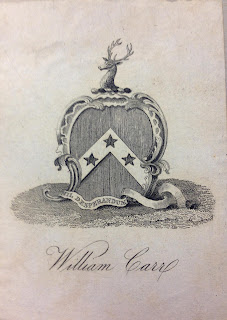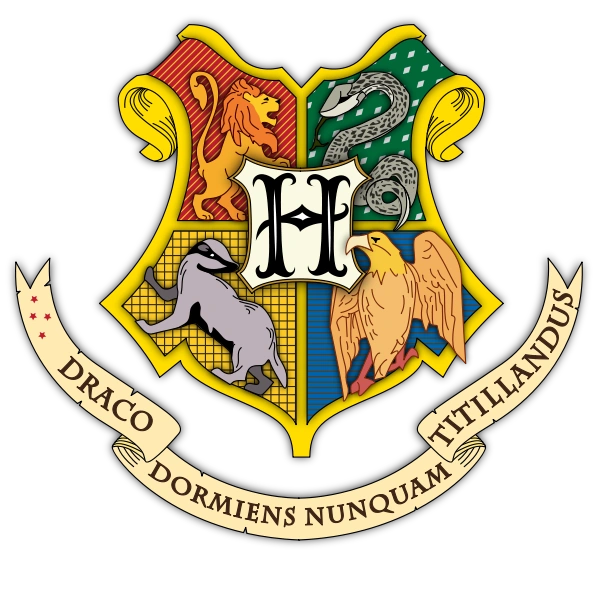Well, it has been an incredibly interesting time during my internship at the Alexander Turnbull Library. I have enjoyed my work there so much - it is a lovely place to work.
I am so impressed with the way the library is run - if you think about the sheer size and scale of items coming into the library to be catalogued, restored, archived, and photographed, it really is mind-boggling.
Just to give you a feel for the size of a place like the Alexander Turnbull Library, I have included this diagram, which is by no means an exhaustive list.
On my last day I definately felt sad to be leaving - I think I really enjoyed the kind of work I was doing there, and could see how it would be a very interesting and satisfying role. There is however, a possibility that an exhibition may come about over the next two years of the Bookplate Collection, which would be a fantastic opportunity.
I finished the day with a tour around the photographic areas of the archive, namely Collection Care; a look at photographs, negatives, and glass plate storage, and also was able to look at some beautiful examples of Tintypes, Daguerrotypes, and even an Opaltype.
The staff have been so generous showing me around, and discussing different areas of the Library with me. I'd especially like to thank Barbara Lyon, for taking me under her wing, and offering to take on an intern; Rachel Esson, for making my internship possible; and Ruth Oliver for her time in the photography department.
The Rampant Hippogriff
Thursday 3 March 2016
Wednesday 2 March 2016
How Graham's bookplates are stored
And so, when one thinks of a bookplate - you imagine it in its home, safe, at the front of a beautiful book. This is definately a safe place for it to live, but over the years the bookplate has become in itself just as special, and indeed valuable as its caretaker.
Bookplates became a popular item in themselves to collect, and so then were lifted from their present homes to be a single loose sheet of paper. In the Library, they have a particular way of storing these: first of all attached to a sheet of acid-free paper, then interleaved with acid-free cardboard to give some weight to the protective layer. These in turn are stored within robust, specially made acid-free boxes for the library.
Bullock, Bernie, Campbell, Carr.....
Edward Bullock
Motto: Nil Conscire sibi - Conscious of no wrong
A plain armorial with the motto in a ribbon at the base. As blazon, a beehive with a single bee. In the shield white in one half, and a party per chevron with two bull heads in the other.
Edward C. Bullock (1822–1861) was an American politician and Confederate officer in the American Civil War. (https://en.wikipedia.org/wiki/Edward_Bullock)
William Burnie
Motto: Arcus Artes Astra - the bow, arts, and stars
Festoon armorial with a demi-lion as blazon. In the shield, a bow and arrow, a hand holding an ancor, three legs, with knees embowed. On the second half, two javlin, cossed with a mullet star and a crescent.
William Burnie m. circa 1880. Born in Kirkmabreck to Hugh Carsriggan Burnie and Jane Douglas. William married Agnes Templeton and had 13 children. He passed away on 1925.
(http://www.ancestry.com.au/genealogy/records/william-burnie_46039823)
Burnie is a port city on the north-west coast of Tasmania. When founded in 1827, Burnie was named Emu Bay but it was renamed for William Burnie, a director of the Van Diemen's Land Company, in the early 1840s. (https://en.wikipedia.org/wiki/Burnie,_Tasmania)
OR
William Burnie (1760 - 1836) , in Cuil, Kirkcudbright, Scotland
(http://www.wikitree.com/wiki/Burnie-28)
W.H. Campbell
Motto: Ne Obliviscaris – Forget Not
A stylised Plain Armorial with a characterful boar’s head as blazon, and in the shield two ancient sailing boats, and two grony of eight.
Campbell, William Henry, 1814-1888, M.D. (http://www.parliament.vic.gov.au/vufind/Record/82139/Details)
Collegium sive Aula D.Catharinae in Universitae Cantabrigiensi
Early Jacobian armorial - wheel depicted on their shield is a breaking wheel, a torture/execution device of the middle ages
Mention of bookplate : Title: A Short View of the Immorality and Profaneness of the English Stage, Together with the Sense of Antiquity Upon this Argument
Author: Collier, Jeremy. Date: 1698. Description: Full leather, blind stamped and tooled, goffered edges in gold. Laid paper with watermark. Long 'S' type, Italic, Roman, and Gothic type. Text primarily English with some French and Latin. Marginal notes, catchwords, and signatures. Publisher's advertisement. Errata at end of table of contents. Decorated bookplate "Collegium sive aula D. Catharinae in Universitate Cantabrigiensi."
Call #: PN2047 C6 1698 (Rare Book)
(http://www.csuchico.edu/lbib/spc/iepages/rarebookhighlights.html)
Ex Bibliotheca Collegii Santissimae et Individuae Trinitatis in Academia Cantabrigien si
Motto: Virtus Vera Nobilitas - Virtue is true nobility
Bookplate signed E.W, S.C in small letters.
A Jacobian armorial. Within the shield three roses surrounding a patterned chevron. Motto in ribbon at base. A passant (walking) lion between two closed books.
Probably given as prize.
William Carr
Motto set into ribbon at the base: Nil Desperandum - do not despair; never despair.!
A plain armorial with three mullet stars in a chevron, with a demi-stag as blazon.
William Carr (1664–1720)
OR William Carr II, FRS (died 16 May 1742) was an English mayor and Member of Parliament (MP) for Newcastle-upon-Tyne. (both https://en.wikipedia.org/wiki/William_Carr)
Draco dormiens nunquam titillandus
(Never tickle a sleeping dragon).
Just as an aside - a completely unrelated to ATL post. Both my kids are devout fans of all the Harry Potter books, and so on the lead up to Christmas, in our holidays, I started to make them their own Harry Potter capes, with the Hogwarts Coat of Arms (as below).
Here are our (almost finished) efforts:
This Weeks Favourites
Joseph Grote
Joseph Grote (1748-1814) ( http://www.geni.com/people/Joseph-Grote/6000000027650437557)
Riversdale W. Grenfell
Francis Octavius Grenfell, VC (4 September 1880 – 24 May 1915) was an English recipient of the Victoria Cross. He was born on 4 September 1880 to Sophia and Pascoe Du Pré Grenfell. He was one of fifteen children. He had a twin brother, Riversdale Grenfell, also in the 9th Lancers, who was killed in action in September 1914. (https://en.wikipedia.org/wiki/Francis_Octavius_Grenfell)
Randolph Greenway of Thavies Inn and of Chertley in Surry Gent
UK Register of Duties Paid for Apprentices Indentures, 1710-1811; Randolph Greenway, residence: 4 Nov 1731 – Thavies Inn
(http://search.ancestry.co.uk/cgi-bin/sse.dll?gl=CLP_TAX&uidh=000&rank=1&new=1&msT=1&gsln=Greenway&gss=angs-g&MS_AdvCB=1&MSAV=2&gsfn_x=XO&gsln_x=XO&cp=0&cpxt=0&catBucket=rstp&noredir=true&so=2&geo_a=r&geo_s=uk&geo_t=uk&geo_v=2.0.0&o_iid=41012&o_lid=41012&o_sch=Web+Property)
A Plain Armorial with double blazon – the left a hunting horn with the sun in splendour shining through; and to the right a stag’s head per fess indented, holding in its mouth a fleur-de-lis. In the shield are motifs of the hunting horn, displayed griffin, and fleur-de-lis.
Geographer and geologist (1778-1885)
George Bellas Greenough FRS FGS (18 January 1778 – 2 April 1855) was an English geologist (https://en.wikipedia.org/wiki/George_Bellas_Greenough)
A Plain Armorial with motto: Meliora Sequi – I follow better things. As blazon, a bow and arrow sitting between thistle leaves. In the shield are thistles, mullet stars, vair patterning and a saltire cross.
Elliot Blair Grasett, b. October 12, 1888, Allensmore, Herefordshire, Died September 25, 1915 in Battle of Loos
George Bellas Greenough
Geographer and geologist (1778-1885)
George Bellas Greenough FRS FGS (18 January 1778 – 2 April 1855) was an English geologist (https://en.wikipedia.org/wiki/George_Bellas_Greenough)
Elliot Grasett
Elliot Blair Grasett, b. October 12, 1888, Allensmore, Herefordshire, Died September 25, 1915 in Battle of Loos
(http://www.geni.com/people/Elliot-Grasett/6000000003891362704); Lieutenant, 28th Punjabis, Indian Army (https://www.jesus.cam.ac.uk/about-jesus-college/history/first-world-war/the-roll-of-honour/grasett-elliot-blair/)
Grant (Lt. Col. F. R. C.)( typed on bookplate surround))
E libris Francisci R. C. Grant. A Pictorial bookplate with name around outside border.
The shield bears a chevron engrailed ermine between three eastern crowns. The motto above the shield reads Leges juraque serva - Observe the laws and ordinances. There are also roses surrounding the shield.
Another bookplate in the Clements Collection National Art Library
Armorial bookplate: “E libris Francisci R. C. Grant” [Franks 12518]
Grant, Francis Richard Charles (1834 - 1899)( https://armorial.library.utoronto.ca/node/34446)
Francisci R. C. Grant
E libris Francisci R. C. Grant. A Pictorial bookplate with name around outside border.
The shield bears a chevron engrailed ermine between three eastern crowns. The motto above the shield reads Leges juraque serva - Observe the laws and ordinances. There are also roses surrounding the shield.
Another bookplate in the Clements Collection National Art Library
Armorial bookplate: “E libris Francisci R. C. Grant” [Franks 12518]
Grant, Francis Richard Charles (1834 - 1899)( https://armorial.library.utoronto.ca/node/34446)
Bonouvrier Glover
Mention of: The baronetage of England 1839 – Bonouvrier Glover (1760s) (https://books.google.co.nz/books?id=7CEIAAAAQAAJ&pg=PA320&lpg=PA320&dq=Bonouvrier+Glover&source=bl&ots=rF4QpG5akq&sig=4ZMsdy-dkoGZYljYdptrKFx31g0&hl=en&sa=X&ved=0ahUKEwj3hubU8qfKAhUDi5QKHXTzBQUQ6AEIIDAB#v=onepage&q=Bonouvrier%20Glover&f=false)
Will of Bonouvrier Glover, Captain in His Majesty's Royal Navy of Queen Ann Street near Cavendish Square , Middlesex, 16 August 1780 (http://discovery.nationalarchives.gov.uk/details/r/D382363)
Norcliffe Gilpin
Norcliffe Gilpin. Regiment: 37th Foot. Date of Service: 1859. Born: 1840. (http://discovery.nationalarchives.gov.uk/details/r/C13291231)
1851 Census Norcliffe Gilpin, b. 1840, residence Sussex. (http://search.ancestry.co.uk/cgi-bin/sse.dll?uidh=000&rank=1&new=1&msT=1&gsln=Gilpin&gss=angs-c&MS_AdvCB=1&MSAV=2&gsfn_x=XO&gsln_x=XO&cp=0&cpxt=0&catBucket=rstp&noredir=true&gl=CEN_1850&gst=&ghc=50&fh=550&fsk=BEFmZmYIgAAe7gAFIA8-61-&pgoff=11)
Norcliffe Gilpin (of Palewell) b 14/02/1840 Dublin, c St Ann's, Dublin, m.,Louise Maria Nassar, living 1903.
Norcliffe is on the 1881 census, living in London. (http://archiver.rootsweb.ancestry.com/th/read/GILPIN/2001-04/0987661567)
Lieut-Col. Alexander K. Gillespie
Sir Nevile Wilkinson – engraver.
Wilkinson, Sir Nevile Rodwell (1869–1940), army officer, artist, and herald, was born on 26 October 1869 at Highgate, Middlesex, the third son of Colonel Josiah Wilkinson. Wilkinson established the heraldic museum at the Ulster office in 1909—the first of its kind in the world. http://www.oxforddnb.com/view/article/36905
Lieut-Col. Alexander K. Gillespie, The London Gazette, Jan 14th, 1910 – Army Pay Department. Lieutenant-Colonel Alexander K. Gillespie, Staff Paymaster, retires on retired pay. Dated 15th January, 1910. https://www.thegazette.co.uk/London/issue/28329/page/341/data.pdf)
Charles Pierrepont Hutchinson
A (garter) seal Armorial, with a Wyvern (or firedrake) as blazon. There is a rampant lion in the centre of the shield surrounded by ten cross crosslets.
Charles Pierrepont Hutchinson QSO, MBE, QC, 1906 – 1997. Charles Pierrepont Hutchinson – believed to be the country’s oldest Queen’s Counsel – died in Auckland on 5 August 1997 aged 91. Born in Wiltshire in the United Kingdom, Mr Hutchinson immigrated to New Zealand in 1925, working as a farmer until he became a law student in 1936. Admitted to the bar in New Zealand in 1940, he was called to the bar of England and Wales (Lincoln’s Inn) in 1945 and practised in London from 1945 to 1953. He was a partner in Russell McVeagh from 1955 to 1964, when he left the firm to take silk. (https://www.lawsociety.org.nz/news-and-communications/people-in-the-law/obituaries/obituaries-list/charles-pierrepont-hutchinson-qso,-mbe,-qc,-1906-1997)
The Revd Charles Pierrepont Hutchinson (1831/2-1898), who was descended from the father of the regicide John Hutchinson (http://oxfordindex.oup.com/view/10.1093/ref:odnb/34072)
Edward Nicholas Hurt
Armorial with the motto: Mane prœdam, vespere spolium - Game in the morning and a feast at night. As blazon a stag trippant, pierced by an arrow in the haunch, with a crescent pierced on its side. Motifs in the shield include cinquefoil, pierced crescents, a trippant stag, a hunting horn, cross-crossletts fitchee, and a fess, chevron.
Edward Nicholas Hurt – b. Jan 17 1795, Derbyshire – d. Aug 7 1867, London. (http://www.geni.com/people/Edward-Nicholas-Hurt/6000000008622632264)
1812, Articles of clerkship (as a solicitor or attorney) for Edward Nicholas Hurt, articled to William J Lockett, with affidavit. (http://discovery.nationalarchives.gov.uk/details/r/C13350007)
Hunter Weston (Gould) Lieut.-Col.
Typed on surround – 1823-1904, Commanded in Indian Mutiny, etc. Armorial.
Golden Age Armorial. Motto: Aquila non captat muscas - The eagle doesn't capture flies (don't sweat the small stuff). There are two blazons – the left: an eagle regardent with wings outstretched, with a crescent on the beast and each wing; the right a sejant greyhound with a antique crown around its neck, with a cross-crosslett on its shoulder. On the shield, motifs of the hunting horn, ermine pattern, cross-crosslett, cross-patonce, marletts, crescents and displayed eagles.
Lieutenant-General Sir Aylmer Gould Hunter-Weston KCB DSO GStJ (23 September 1864 – 18 March 1940) was a British Army general who served in World War I at Gallipoli and in the very early stages of the Somme Offensive. He was also a Member of Parliament. (https://en.wikipedia.org/wiki/Aylmer_Hunter-Weston)
Travers Christmas Humphreys
Armorial with motto: Be Always Just. As blazon, a horse’s head. In the shield, a lion passant guardant, and a group of three horse’s heads.
Travers Christmas Humphreys, QC (15 February 1901 – 13 April 1983) was an English barrister who prosecuted several controversial cases in the 1940s and 1950s, and later became a judge at the Old Bailey. He also wrote a number of works on Mahayana Buddhism. In his day he was the best-known British convert to Buddhism (https://en.wikipedia.org/wiki/Christmas_Humphreys)
The Alexander Turnbull Library
The National Library website, http://natlib.govt.nz/ has a very good thorough description of the ATL, so I will let them introduce you to it here:
The Alexander Turnbull Library (ATL) is a ‘library within a library’. Established in 1920 after Alexander Horsburgh Turnbull gifted his collection to the nation in 1918, “as the nucleus of a New Zealand National Collection”, its collections are now housed within the National Library building in Wellington.
The Turnbull Library collections are based on Turnbull’s personal library of books, manuscripts, photographs, paintings and sketches. Over time the collections have grown many times over through donation, bequest, legal deposit, and targeted purchasing to contain millions of items, including digitally-born material, sound recordings and oral histories.
The purpose of the Turnbull Library is:
- to preserve, protect, develop and make accessible for all the people of NZ the collections of that library in perpetuity and in a manner consistent with their status as documentary heritage and taonga; and
- to develop research collections and the services of the ATL particularly in the fields of New Zealand and Pacific studies and rare books; and
- to develop and maintain a comprehensive collection of documents relating to New Zealand and the people of NZ.
Tuesday 1 March 2016
The Monaghan Coat of Arms
My mother's surname is Monaghan, and my father's is O'Brien. My mother had this Monaghan Coat of Arms tucked away at home:
Translated simply:
Azure - the colour azure blue; a chevron, between three mullets (regular looking stars) or (the french for gold - in this case the colour of the stars and the chevron).
A knight in complete armour resting the sinister (Latin for left) hand on the hip, and holding in the dexter ( Latin for right) a tilting spear (the weapon), thereon a forked pennon (flag) argent (from the Latin for silver), charged with an escutcheon (shield shape) of the arms.
The motto: Felis demulcta mitis means The stroked cat is meek, meaning something along the lines of Gentle in Peace, Fearless in War.
Translated simply:
Azure - the colour azure blue; a chevron, between three mullets (regular looking stars) or (the french for gold - in this case the colour of the stars and the chevron).
A knight in complete armour resting the sinister (Latin for left) hand on the hip, and holding in the dexter ( Latin for right) a tilting spear (the weapon), thereon a forked pennon (flag) argent (from the Latin for silver), charged with an escutcheon (shield shape) of the arms.
The motto: Felis demulcta mitis means The stroked cat is meek, meaning something along the lines of Gentle in Peace, Fearless in War.
Wednesday 17 February 2016
A Glossary of Heraldic Terms
A little list I've been colating as I go...
Annulet
A roundel with a hole in the centre, like a ring
Argent
The tincture Silver
Billet
A small rectangle (usually vertical), representing bricks, books or tickets
Blazon
The symbol sitting at the top of the armorial
Buckle
An artistic representation of a buckle, but used by Earls, and Counts

Caped
Cut off at the neck
Catherine Wheel

Chapeau
Hat/ Ecclesiastical dignity
Clarion
A harp

Coat of Arms
The unique heraldic design on an escutcheon
Couchant
Lying down, head raised
Courant
At running speed, or in full chase
Crosses
Dexter
Right
Displayed
Wings outstretched
Ducal
Of the Duke
Erased
Looks like forcably torn off, i.e., head.
Escallop
The scallop shell - often used as a badge of pilgrims going to the Holy Land

Escarbuncle
Shields were strengthened by these iron bands

Escutcheon
Shield or Emblem bearing a Coat of Arms
Estoile
Wavy-armed star
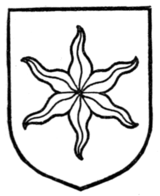
Fitchee
To a point, i.e. a cross crosslet fitchee. Fitched - pointed end.
Fleam
A surgeon's lancet
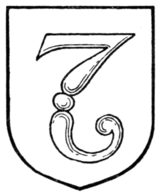
Furs
Are the small patterns repeated on a shield, such as ermine (stoat) or vair (squirrel)
(look under tincture wiki)
Gamelle
One of Two, e.g. gemelle bars
Grenade
Fire ball

Guardant
Looking at you
Increscent
Horns turned Dexter
Halberd
Two handled pole weapon, sometimes axe/pole.
Lozenge
A diamond shape
Lodged
Martlett
Small bird - usually a swallow or lark.
Mascle
A lozenge shape voided
Mantle
A cloak, or a piece of fabric used to highlight the arms and the crest


Maunch
Ladies sleeve
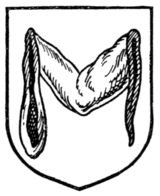
Mill-rind
Iron from the centre of a grindstone

Mitre
Bishops Hat
Mullet
Star

Mural Crown
Representation of a city wall or towers in the form of a crown

Or
French for Gold
Pale
Band running straight up and down on shield
Passant
Animal striding/walking (on all fours)
Pheon
A broad arrow

Portcullis
Iron gate on a castle or fort

Rampant
Standing on hind legs
Regardant
Looking backward
Roundel
A round disc or ball
Salient
Of animal standing on hind legs as if leaping at the ready.
Saltire
Diagonal Cross
Scimitar
Type of sword

Sejant
Sitting upright (animal)
Semeé
Being embellished with - stars, etc
Sinister
Left
Spur
Used on the boots of armour
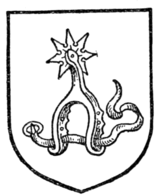
Statant
On all fours, but erect, e.g. lion.
Sun in splendor
The sun with a face, and arms of rays
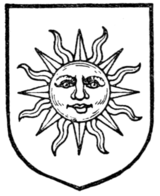
Supporters
The figures placed on either side of the shield - usually humans or animals
Talbot
Dog or hunting dog
Tilting Spear
Weapon of the Day, used for tournaments

Tinctures
The colours used to emblazon a coat of arms. These are divided into metals, colours, stains, furs, and proper (coloured as it would be in nature).
Vulning
Wounded
Water bouget
The sticks with which water buckets were carried over the shoulders

Ordinaries
Simple geometrical feature, with straight lines running from side to side or top to bottom of the shield. Each represents a different aspect of the family, often with additions of motifs, colours, or patterns.

Divisions of the Field

Lines of Partition

Variations of the Field

Common Symbols

Crowns

(Most common being the Duke).

(Most common are the Mural, Ducal, and Naval crowns).
Other Heraldic Headwear

(Of these the most common in my research has been the chapeau, the mitre, and the chaplet).
Familial Position in Heraldry

(Of these the most common reocurring motifs have been the label, crescent, mullet, escallop, fleur-de-lis, and martlet).
Annulet
A roundel with a hole in the centre, like a ring
Argent
The tincture Silver
Billet
A small rectangle (usually vertical), representing bricks, books or tickets
Blazon
The symbol sitting at the top of the armorial
Buckle
An artistic representation of a buckle, but used by Earls, and Counts

Caped
Cut off at the neck
Catherine Wheel

Chapeau
Hat/ Ecclesiastical dignity
Clarion
A harp

Coat of Arms
The unique heraldic design on an escutcheon
Couchant
Lying down, head raised
Courant
At running speed, or in full chase
Crosses
Dexter
Right
Displayed
Wings outstretched
Ducal
Of the Duke
Erased
Looks like forcably torn off, i.e., head.
Escallop
The scallop shell - often used as a badge of pilgrims going to the Holy Land

Escarbuncle
Shields were strengthened by these iron bands

Escutcheon
Shield or Emblem bearing a Coat of Arms
Estoile
Wavy-armed star

Fitchee
To a point, i.e. a cross crosslet fitchee. Fitched - pointed end.
Fleam
A surgeon's lancet

Furs
Are the small patterns repeated on a shield, such as ermine (stoat) or vair (squirrel)
(look under tincture wiki)
Gamelle
One of Two, e.g. gemelle bars
Grenade
Fire ball

Guardant
Looking at you
Increscent
Horns turned Dexter
Halberd
Two handled pole weapon, sometimes axe/pole.
Lozenge
A diamond shape
Lodged
Martlett
Small bird - usually a swallow or lark.
Mascle
A lozenge shape voided
Mantle
A cloak, or a piece of fabric used to highlight the arms and the crest


Maunch
Ladies sleeve

Mill-rind
Iron from the centre of a grindstone

Mitre
Bishops Hat
Mullet
Star

Mural Crown
Representation of a city wall or towers in the form of a crown

Or
French for Gold
Pale
Band running straight up and down on shield
Passant
Animal striding/walking (on all fours)
Pheon
A broad arrow

Portcullis
Iron gate on a castle or fort

Rampant
Standing on hind legs
Regardant
Looking backward
Roundel
A round disc or ball
Salient
Of animal standing on hind legs as if leaping at the ready.
Saltire
Diagonal Cross
Scimitar
Type of sword

Sejant
Sitting upright (animal)
Semeé
Being embellished with - stars, etc
Sinister
Left
Spur
Used on the boots of armour

Statant
On all fours, but erect, e.g. lion.
The sun with a face, and arms of rays

Supporters
The figures placed on either side of the shield - usually humans or animals
Talbot
Dog or hunting dog
Tilting Spear
Weapon of the Day, used for tournaments

Tinctures
The colours used to emblazon a coat of arms. These are divided into metals, colours, stains, furs, and proper (coloured as it would be in nature).
Vulning
Wounded
Water bouget
The sticks with which water buckets were carried over the shoulders

Ordinaries
Simple geometrical feature, with straight lines running from side to side or top to bottom of the shield. Each represents a different aspect of the family, often with additions of motifs, colours, or patterns.
Sub-Ordinaries

Divisions of the Field

Lines of Partition

Variations of the Field


Crowns

(Most common being the Duke).

(Most common are the Mural, Ducal, and Naval crowns).
Other Heraldic Headwear

(Of these the most common in my research has been the chapeau, the mitre, and the chaplet).
Familial Position in Heraldry

(Of these the most common reocurring motifs have been the label, crescent, mullet, escallop, fleur-de-lis, and martlet).
Subscribe to:
Posts (Atom)
My last day
Well, it has been an incredibly interesting time during my internship at the Alexander Turnbull Library. I have enjoyed my work there so muc...

-
My mother's surname is Monaghan, and my father's is O'Brien. My mother had this Monaghan Coat of Arms tucked away at home: Trans...
-
A little list I've been colating as I go... Annulet A roundel with a hole in the centre, like a ring Argent The tincture Silver Billet A...








